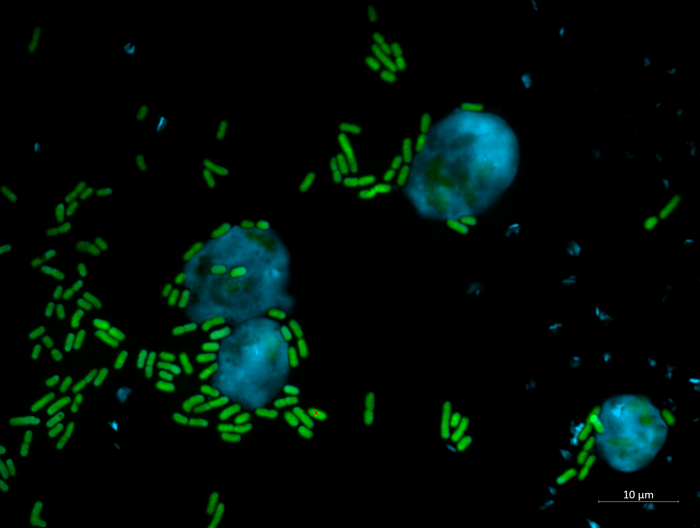Bacteria of the genus Pseudomonas produce a strong antimicrobial natural product, as researchers at the Leibniz Institute for Natural Product Research and Infection Biology (Leibniz-HKI) in Jena, Germany, have discovered. They proved that the substance is effective against both plant fungal diseases and human-pathogenic fungi. The study was published in the Journal of the American Chemical Society.

Credit: Harikumar Suma/Leibniz-HKI
Bacteria of the genus Pseudomonas produce a strong antimicrobial natural product, as researchers at the Leibniz Institute for Natural Product Research and Infection Biology (Leibniz-HKI) in Jena, Germany, have discovered. They proved that the substance is effective against both plant fungal diseases and human-pathogenic fungi. The study was published in the Journal of the American Chemical Society.
The newly discovered natural product group of keanumycins in bacteria works effectively against the plant pest Botrytis cinerea, which triggers grey mould rot and causes immense harvest losses every year. But the active ingredient also inhibits fungi that are dangerous to humans, such as Candida albicans. According to previous studies, it is harmless to plant and human cells.
Keanumycins could therefore be an environmentally friendly alternative to chemical pesticides, but they could also offer an alternative in the fight against resistant fungi. “We have a crisis in anti-infectives,” explains Sebastian Götze, first author of the study and postdoc at Leibniz-HKI. “Many human-pathogenic fungi are now resistant to antimycotics – partly because they are used in large quantities in agricultural fields.”
Deadly like Keanu Reeves
The fact that the researchers have now found a new active ingredient in bacteria of the genus Pseudomonas is no coincidence. “We have been working with pseudomonads for some time and know that many of these bacterial species are very toxic to amoebae, which feed on bacteria,” says study leader Pierre Stallforth. He is the head of the department of Paleobiotechnology at Leibniz-HKI and professor of Bioorganic Chemistry and Paleobiotechnology at Friedrich Schiller University in Jena. It appears that several toxins are responsible for the deadly effect of the bacteria, of which only one was known so far. In the genome of the bacteria, the researchers have now found biosynthesis genes for the newly discovered natural products, the keanumycins A, B and C. This group of natural products belongs to the nonribosomal lipopeptides with soap-like properties.
Together with colleagues at the Bio Pilot Plant of the Leibniz-HKI, the researchers succeeded in isolating one of the keanumycins and conducting further tests. “The lipopeptides kill so efficiently that we named them after Keanu Reeves because he, too, is extremely deadly in his roles,” Götze explains with a wink.
The researchers suspected that keanumycins could also kill fungi, as these resemble amoebas in certain characteristics. This assumption was confirmed together with the Research Centre for Horticultural Crops at the University of Applied Sciences Erfurt. There, Keanumycin was shownto be effective against grey mould rot on hydrangea leaves. In this case, culture fluid that no longer contained bacterial cells was sufficient to significantly inhibit the growth of the fungus.
“Theoretically, the keanumycin-containing supernatant from Pseudomonas cultures could be used directly for plants,” says Götze. Further testing will be carried out together with the colleagues in Erfurt. Keanumycin is biodegradable, so no permanent residues should form in the soil. This means that the natural product has the potential to become an environmentally friendly alternative to chemical pesticides.
Fungal diseases such as Botrytis cinerea, which causes grey mould rot, cause immense harvest losses in fruit and vegetable cultivation every year. More than 200 different types of fruit and vegetables are affected, especially strawberries and unripe grapes.
Possible applications in humans
“In addition, we tested the isolated substance against various fungi that infect humans. We found that it strongly inhibits the pathogenic fungus Candida albicans, among others,” says Götze.
Instead of plants, Keanumycin could therefore possibly also be used in humans. According to the tests conducted so far, the natural product is not highly toxic for human cells and is already effective against fungi in very low concentrations. This makes it a good candidate for the pharmaceutical development of new antimycotics. These are also urgently needed, as there are very few drugs against fungal infections on the market.
The work was supported by the Werner Siemens Foundation, the Leibniz Association and the German Research Foundation (Deutsche Forschungsgemeinschaft, DFG) as part of the Balance of the Microverse Cluster of Excellence, and funded by the Dr. Illing Foundation.
The study was highlighted by Nature in a “News & Views” article.
Journal
Journal of the American Chemical Society
DOI
10.1021/jacs.2c11107
Method of Research
Experimental study
Article Title
Ecological niche-inspired genome mining leads to the discovery of crop-protecting nonribosomal lipopeptides featuring a transient amino acid building block
Article Publication Date
20-Jan-2023




